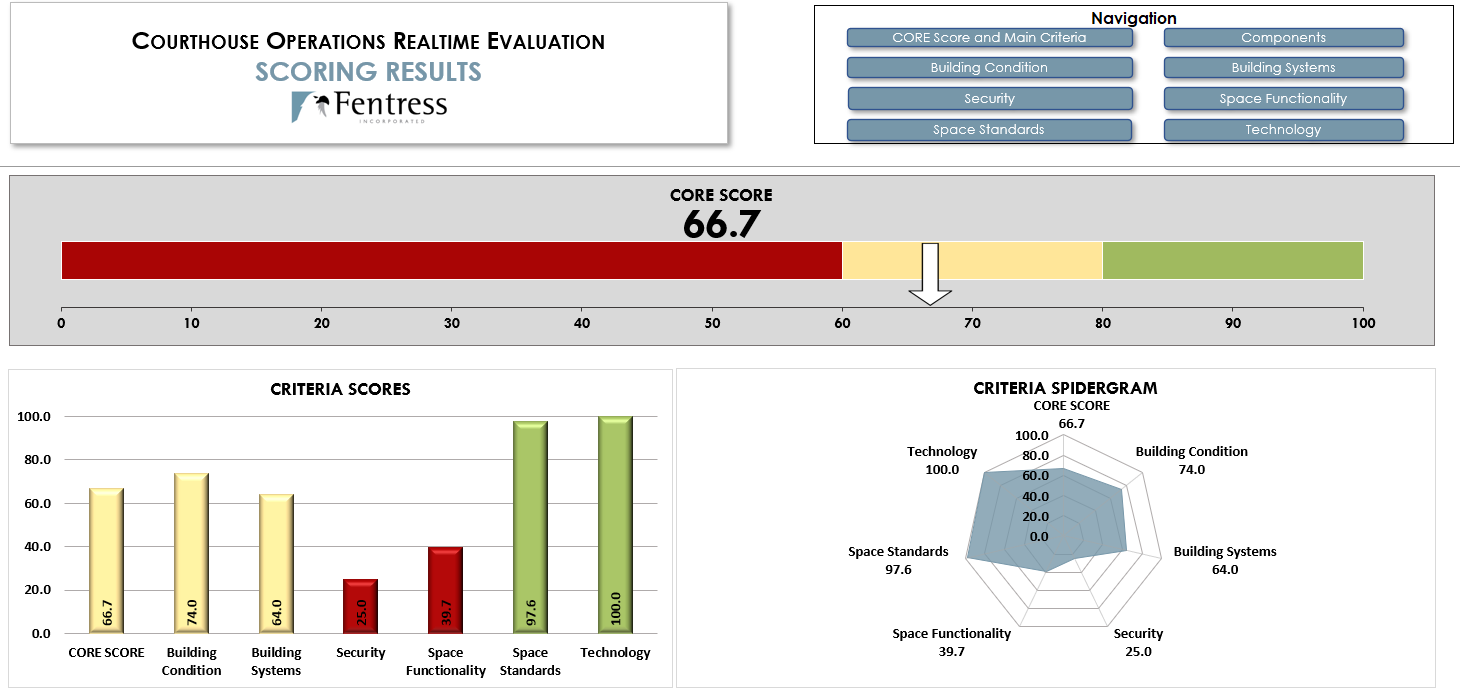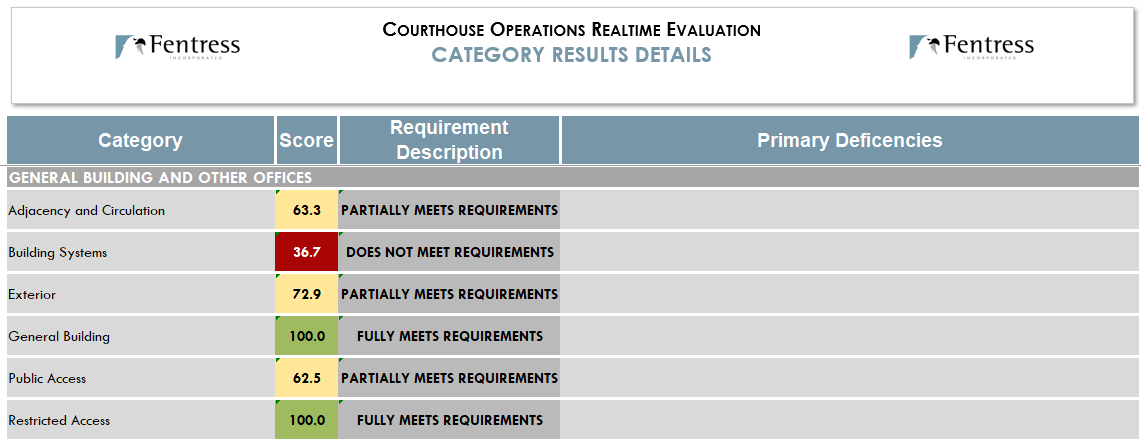Courthouse planning involves analyzing a courthouse to make critical decisions about how best to use the space. A court planning consultant should be an expert in courthouses, not just in space or design. They should also understand court operations and how they relate to space needs.
A needs assessment analyzes options for meeting present and future space needs and provides the basis for making recommendations on the best course of action. This assessment is performed at a high level and is designed to provide guidance to a court that has concerns about either its existing facilities or its future operations.
Courthouse needs assessments are greatly enhanced by using a tool that produces quantifiable, comparable assessment results.
Introducing the Courthouse Operations Realtime Evaluation (CORE) tool.
CORE Tool Description
At Fentress, we conduct our assessments using our unique CORE tool, which contains a library of over 500 courthouse performance factors and accompanying metrics. We apply a customized subset of these factors, as applicable, to each courthouse assessment project. Utilizing performance metrics helps identify deficiencies within the existing courthouse.
The CORE tool is designed to focus on the following five criteria: building condition, space functionality, space standards, security, and technology.
- Building Condition – the condition of the general building and judiciary tenant space of the facility, including the general condition of the court spaces, common areas, lobbies, elevators and stairways, and exterior spaces on the site (e.g., plaza, walkways, and parking)
- Space Functionality – the extent to which space supports the number and operations of judges and staff and functions properly for adjacencies, layout, accessibility, and circulation
- Space Standards – the conformance of space with the jurisdiction’s applicable standards for size, quantity, and proportion; best practices are used if standards are not available
- Security – the security features in the facility, such as public, restricted, and secure circulation patterns; prisoner holding areas; sallyports; and courtroom holding cells
- Technology – the availability of technology systems in the courthouse to support court proceedings, public access, and coordination among court components
The performance metrics are applied to all spaces within the courthouse, including courtrooms, chambers, office spaces, public spaces, and secure spaces. Using the CORE tool metrics, courthouse planners and architects are able to assess a courthouse and determine a quantifiable score for each criterion as well as for the courthouse as a whole.
The result of the CORE assessment is a score between 0 and 100, with a score of 100 representing an ideal courthouse.

The image above presents a CORE tool dashboard of a courthouse that scored in the “fair” range. Space standards and technology score the highest (green bars), security and space functionality score the lowest (red bars), and all other criteria score in the middle (yellow bars).
Now that you have an understanding of what the CORE tool is, let’s take a look at some practical applications of the tool.
CORE Tool Usages
Identify Deficiencies
The CORE tool not only identifies deficiencies at the highest level, it can also help courthouse planners and architects take a deep dive into deficiencies with specific spaces. The tool allows users to view their scores across various categories, including adjacency and circulation, building systems, exterior, general building, public access, and restricted access, among others. And more importantly, the tool allows users to identify the primary concerns in any areas that score lower than desired.
The image below shows an example of category results such as general building, building systems, and public access.

Evaluate Future Options
Once you have a CORE score for your existing courthouse, you can use the tool to choose among multiple improvement strategies to address current and future space needs. Improvement strategies could include renovation within the existing courthouse, an addition to the existing courthouse, construction of a new courthouse, or a combination of these solutions.
For example, a courthouse scores a 57.9, which is “poor.” There are two options that the team is considering to increase the score. Option A results in a score of 75.4, which is a considerable increase, but Option B increases the score to 83.9. In this case, Option B would be the most beneficial.
Don’t worry… I know what you are thinking. But what about the costs associated with each option? That is a very valid question, which brings me to another use I’d like to discuss regarding the CORE tool.
If you have CORE scores for each option and you have costs associated with each option, the tool has the ability to calculate the “cost per point” for each option. In other words, how much does it cost to increase the CORE score by one point?
Looking at our previous example, if Option A costs $250,000 to increase the CORE score by one point, but it costs $750,000 per point for Option B, then Option A might be the most cost-effective solution, despite Option B initially appearing to be the most beneficial option.
Prioritize Across a Portfolio of Courthouses
The CORE score can be used to provide an objective measure for prioritizing project phasing and funding. Priority setting can happen for a single courthouse, across a judicial complex, or a portfolio of courthouses across a region or state.
Using the same tool as a starting point for assessing multiple courthouses brings a consistency to the process, which allows for fair and meaningful comparisons. In other words, courthouses, as well as courthouse projects, can be compared on an “apples to apples” basis, which is extremely helpful when prioritizing projects across a portfolio.
The level of detail that the CORE tool provides is useful beyond measure. Imagine being able to determine all of the common problems (e.g., roof leaks, lack of sallyports) across your portfolio of courthouses by simply comparing the category results details for all of the buildings. Or being able to rank all prospective projects across your portfolio based on a quantifiable urgency of need. Once your assessment data are loaded into the tool, slicing and dicing the data in a multitude of ways is a very simple process.
Final Thoughts
Needs assessments are a critical piece in courthouse planning, so why rely on a simple checklist to get the job done? The sophistication of the CORE tool can provide the foundation for quantifiable, comparable, and defensible results that will allow your court to efficiently and effectively plan for future improvements.



.jpg)

.jpg)
.jpg)
.jpg)
.jpg)
.jpg)
.jpg)


-1.jpg)
.jpg)
.jpg)

